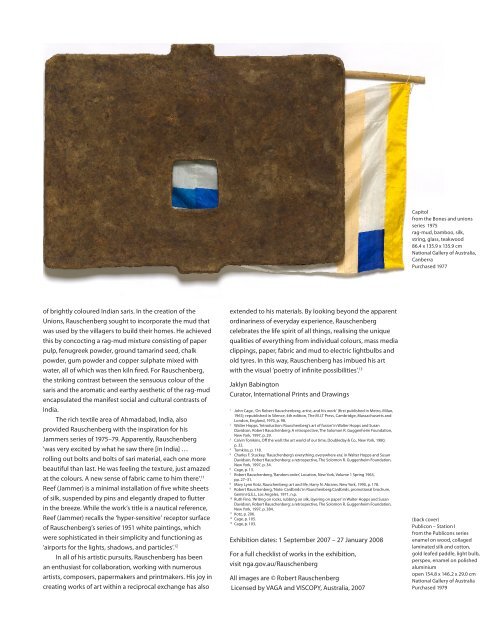Download Room Brochure - National Gallery of Australia
Download Room Brochure - National Gallery of Australia
Download Room Brochure - National Gallery of Australia
You also want an ePaper? Increase the reach of your titles
YUMPU automatically turns print PDFs into web optimized ePapers that Google loves.
Capitol<br />
from the Bones and unions<br />
series 1975<br />
rag-mud, bamboo, silk,<br />
string, glass, teakwood<br />
86.4 x 135.9 x 135.9 cm<br />
<strong>National</strong> <strong>Gallery</strong> <strong>of</strong> <strong>Australia</strong>,<br />
Canberra<br />
Purchased 1977<br />
<strong>of</strong> brightly coloured Indian saris. In the creation <strong>of</strong> the<br />
Unions, Rauschenberg sought to incorporate the mud that<br />
was used by the villagers to build their homes. He achieved<br />
this by concocting a rag-mud mixture consisting <strong>of</strong> paper<br />
pulp, fenugreek powder, ground tamarind seed, chalk<br />
powder, gum powder and copper sulphate mixed with<br />
water, all <strong>of</strong> which was then kiln fired. For Rauschenberg,<br />
the striking contrast between the sensuous colour <strong>of</strong> the<br />
saris and the aromatic and earthy aesthetic <strong>of</strong> the rag-mud<br />
encapsulated the manifest social and cultural contrasts <strong>of</strong><br />
India.<br />
The rich textile area <strong>of</strong> Ahmadabad, India, also<br />
provided Rauschenberg with the inspiration for his<br />
Jammers series <strong>of</strong> 1975–79. Apparently, Rauschenberg<br />
‘was very excited by what he saw there [in India] …<br />
rolling out bolts and bolts <strong>of</strong> sari material, each one more<br />
beautiful than last. He was feeling the texture, just amazed<br />
at the colours. A new sense <strong>of</strong> fabric came to him there’. 11<br />
Reef (Jammer) is a minimal installation <strong>of</strong> five white sheets<br />
<strong>of</strong> silk, suspended by pins and elegantly draped to flutter<br />
in the breeze. While the work’s title is a nautical reference,<br />
Reef (Jammer) recalls the ‘hyper-sensitive’ receptor surface<br />
<strong>of</strong> Rauschenberg’s series <strong>of</strong> 1951 white paintings, which<br />
were sophisticated in their simplicity and functioning as<br />
‘airports for the lights, shadows, and particles’. 12<br />
In all <strong>of</strong> his artistic pursuits, Rauschenberg has been<br />
an enthusiast for collaboration, working with numerous<br />
artists, composers, papermakers and printmakers. His joy in<br />
creating works <strong>of</strong> art within a reciprocal exchange has also<br />
extended to his materials. By looking beyond the apparent<br />
ordinariness <strong>of</strong> everyday experience, Rauschenberg<br />
celebrates the life spirit <strong>of</strong> all things, realising the unique<br />
qualities <strong>of</strong> everything from individual colours, mass media<br />
clippings, paper, fabric and mud to electric lightbulbs and<br />
old tyres. In this way, Rauschenberg has imbued his art<br />
with the visual ‘poetry <strong>of</strong> infinite possibilities’. 13<br />
Jaklyn Babington<br />
Curator, International Prints and Drawings<br />
1<br />
John Cage, ‘On Robert Rauschenberg, artist, and his work’ (first published in Metro, Milan,<br />
1961); republished in Silence, 4th edition, The M.I.T Press, Cambridge, Massachusetts and<br />
London, England, 1970, p. 98.<br />
2<br />
Walter Hopps, ‘Introduction: Rauschenberg’s art <strong>of</strong> fusion’ in Walter Hopps and Susan<br />
Davidson, Robert Rauschenberg: A retrospective, The Solomon R. Guggenheim Foundation,<br />
New York, 1997, p. 29.<br />
3<br />
Calvin Tomkins, Off the wall: the art world <strong>of</strong> our time, Doubleday & Co., New York, 1980,<br />
p. 32.<br />
4<br />
Tomkins, p. 118.<br />
5<br />
Charles F. Stuckey, ‘Rauschenberg’s everything, everywhere era’, in Walter Hopps and Susan<br />
Davidson, Robert Rauschenberg: a retrospective, The Solomon R. Guggenheim Foundation,<br />
New York, 1997, p. 34.<br />
6<br />
Cage, p. 13.<br />
7<br />
Robert Rauschenberg, ‘Random order’, Location, New York, Volume 1 Spring 1963,<br />
pp. 27–31.<br />
8<br />
Mary Lynn Kotz, Rauschenberg: art and life, Harry N. Abrams, New York, 1990, p. 178.<br />
9<br />
Robert Rauschenberg, ‘Note: Cardbirds’ in Rauschenberg:Cardbirds, promotional brochure,<br />
Gemini G.E.L, Los Angeles, 1971, n.p.<br />
10<br />
Ruth Fine, ‘Writing on rocks, rubbing on silk, layering on paper’ in Walter Hopps and Susan<br />
Davidson, Robert Rauschenberg: a retrospective, The Solomon R. Guggenheim Foundation,<br />
New York, 1997, p. 384.<br />
11<br />
Kotz, p. 206.<br />
12<br />
Cage, p. 105.<br />
13<br />
Cage, p. 103.<br />
Exhibition dates: 1 September 2007 – 27 January 2008<br />
For a full checklist <strong>of</strong> works in the exhibition,<br />
visit nga.gov.au/Rauschenberg<br />
All images are © Robert Rauschenberg<br />
Licensed by VAGA and VISCOPY, <strong>Australia</strong>, 2007<br />
(back cover)<br />
Publicon – Station I<br />
from the Publicons series<br />
enamel on wood, collaged<br />
laminated silk and cotton,<br />
gold leafed paddle, light bulb,<br />
perspex, enamel on polished<br />
aluminium<br />
open 154.8 x 146.2 x 29.0 cm<br />
<strong>National</strong> <strong>Gallery</strong> <strong>of</strong> <strong>Australia</strong><br />
Purchased 1979
















